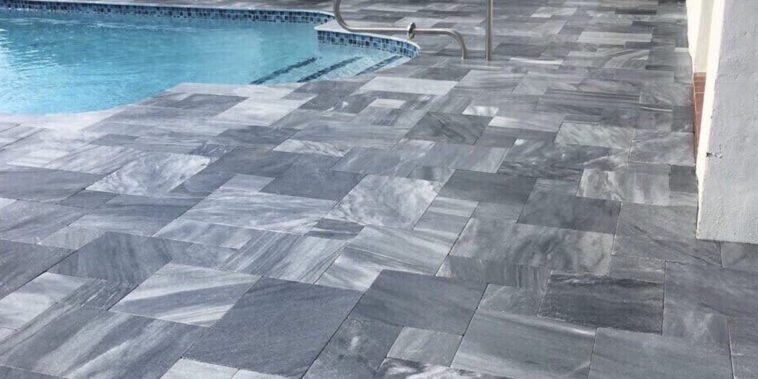Marble has been a staple in the landscaping industry for nearly 2,000 years, first appearing in bathrooms used by the Greeks and Romans. The metamorphic rock is incredibly adaptable and inherently water-resistant and has often demonstrated its usefulness and allure. Rich, black marbles make a striking impact in any area, while a white stone with fine grey veins and gold undertones is a timeless option. The choices are unlimited because so many types of Marble are available, each with unique colours, thicknesses, grains and veining. Many Marble suppliers globally offer a wide range of tiles and pavers for all design opportunities. These can be either polished or honed. Let’s first understand which one is better as a flooring material.
Polished vs Honed Marble in Flooring Design
No matter the finish—polished or honed—Marble tiles and pavers have a porous surface, so sealing is crucial.
In general, we recommend honed Marble over polished Marble since it has a more matte surface. As a result, etching tends to be less visible. However, because natural stone pores are more open, they may stain easily, so seal them. There are some Marble suppliers like Stone Centre who provide Anti Slip Marble. They come under a luxurious collection of stones. The pale grey shades with a darker grey and white splash reflect an Italian-style marble. Durable and resilient, these Marble tiles and pavers last long, keeping your surface radiant forever.
So, now that we know which Marble supplier to choose and what type of tiles or pavers is best, let’s learn how to install them for flooring.
Installation Process of Marble
- Prepare the Subfloor
Like all floor tiles, Marble tiles must be installed on a flat, smooth, water-resistant base. The previous floor covering must be removed to expose the subfloor. Your subfloor needs to be robust because it is a sturdy building material. Before putting in tiles, it might be necessary to perform some structural work to strengthen the joists supporting the subfloor.
- Construct Reference Lines
The Marble tiles will appear finest in your installation if they extend outward from the room’s centre rather than abruptly beginning on one of the walls. You must draw reference lines on the cement board underlayment’s surface to get this symmetrical appearance.
Use a chalk line to mark a path between the centres of two opposing walls, dividing the space in half.
Then, using a T-square and a pencil, draw a perpendicular line at the mark you made by measuring to the line’s centre. Using the pencil line as a reference, draw a chalk line across the floor to divide it into four equal quadrants.
- Mix and Spread the Mortar
The next step is to mix thin-set mortar. Only combine a tiny amount at a time, then add more as needed. The thickness of the thin set, which depends on the size of the tiles and the trowel notch used, is crucial. Preserving the dry mix-to-water ratio is important when combining small amounts. That ratio may be maintained at various mix volumes using a digital kitchen scale, measuring cup and a little maths. Spread the adhesive over the surface with a notched trowel.
- Install the First Marble Tile
A single tile’s bottom should be covered with mortar, and its entire surface should be notched. Place the first Marble tile by gently pressing it into position while ensuring that two edges align with the corner’s chalk lines. Twist the tile slightly as you press it down to ensure it firmly sets in the mortar bed below.
Use a rubber mallet to “set” the tile.
A huge hammer with a soft rubber head is known as a rubber mallet. Using this, lightly tap the marble tile’s surface to press it into the mortar firmly. Although Marble is a rather delicate substance, it can break easily if you tap it too hard. As you are laying the tile, avoid moving it.
- Install Additional Marble Tiles
Spread the mortar as you go, then set each tile before going on to the next one. Use the reference line to maintain your placement straight as you go along it towards the wall. To keep the distance between Marble tiles constant, use tile spacers. Whatever joint width you have picked, the spacers should match. Spacers aid in maintaining uniformity and sharpness in the grout lines.
- Remove Excess Mortar
Use a paint stick or utility knife to scrape away any extra adhesive that has seeped up from the spaces between the Marble tiles. Following the manufacturer’s instructions, let the mortar adhesive completely dry once all the tile has been put in. During this period, avoid walking on the floor to avoid displacing or depressing a tile.
- Seal the Marble Tiles
Due to the porous nature of Marble tiles and pavers, numerous substances have the potential to discolour the stone permanently. Because of this, it needs to be treated with a premium marble tile sealant before grout is applied. If grout is used on marble tile before the Marble has been sealed, it may severely discolour the tile.
- Grout the Marble Tile
As instructed by the manufacturer, mix the grout. Apply the grout to the joints with a grout float, pushing it down into the joints with sweeping motions. Reduce catching edges and achieve a filled joint by running the grout float at a 45-degree angle to the joints. Pushing the grout downward with the tool held slightly on the edge can be helpful. Funnel as much of the mixture as you can into the grooves and clean up any extra that spills onto the tiles. The grout between the joints of the tiles should be filled in, with no voids.
- Wipe the Tiles Clean
To carefully clean the surface of the Marble tiles and get rid of extra grout, use a sizable grout sponge that has been slightly dampened. Avoid allowing any moisture to penetrate the grout lines, as this may result in the mixture becoming muddy and washing away. Additionally, be careful not to accidentally remove grout from the joints while you work with the sponge; concentrate on the Marble tile’s surface.
Final Thought
In conclusion, installing Marble tiles for flooring can add elegance, sophistication and a timeless appeal to any space. Following the step-by-step guide and tips in this blog, you can confidently embark on your Marble tile installation project. Remember, proper preparation is crucial for a successful installation.
This post was created with our nice and easy submission form. Create your post!



Comments
0 comments